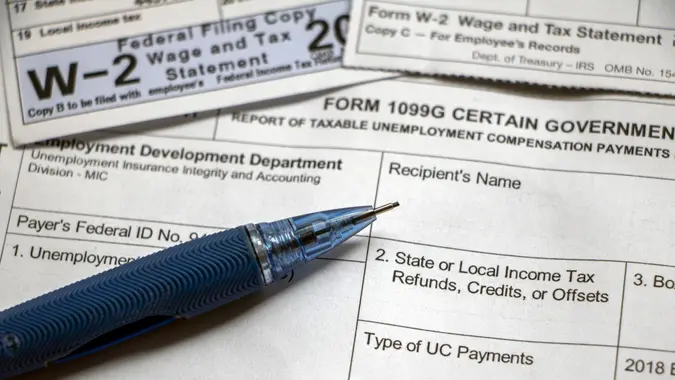5 Middle Class Tax Rules You Need To Know

Commitment to Our Readers
GOBankingRates' editorial team is committed to bringing you unbiased reviews and information. We use data-driven methodologies to evaluate financial products and services - our reviews and ratings are not influenced by advertisers. You can read more about our editorial guidelines and our products and services review methodology.

20 Years
Helping You Live Richer

Reviewed
by Experts

Trusted by
Millions of Readers
The middle class — typically considered those whose annual household incomes are two-thirds to double the national median — face unique financial challenges.
For instance, their incomes haven’t kept pace with those among upper-income households. And the share of aggregate U.S. household income held by the middle class has also fallen steadily since 1970, from 62% to 42% in 2020.
One way to preserve your income and wealth? Get familiar with tax rules. The better you understand how tax laws and write-offs work, the more strategic you can be when you file your return.
Don’t leave money on the table this April — here are six tax rules that can impact middle-class taxpayers’ bottom lines.
Tax Brackets
The federal income tax system in the U.S. is progressive, meaning the tax rate increases as taxable income increases. So higher-income earners pay a larger percentage of their income in taxes compared to lower income earners. However, tax brackets are defined by income ranges, with each range corresponding to a specific tax rate. So if you receive a raise that bumps you into a higher tax bracket, only the portion of income within that range is taxed at the higher rate.
Let’s look at an example. Say you earn $50,000 per year. For the upcoming 2024 tax year (for which taxpayers would file returns in early 2025), there are seven tax brackets ranging from 10% to 37%. Here’s how your income for the year would be taxed as a single filer:
- Up to $11,600: 10%
- $11,601 to $47,150: 12%
- $47,151 to $100,525: 22%
In this scenario, only $2,850 of your income would be taxed at the highest rate of 22% (known as your marginal tax rate). Overall, your effective tax rate would be 16.5%.
“It’s crucial for middle-class taxpayers to understand their tax bracket to plan their finances and tax liabilities effectively,” said Ashley Tison, tax expert and founder of OZPros. “For instance, a higher marginal tax rate may encourage taxpayers to seek ways to reduce their taxable income.”
Retirement Contributions
One of the best ways to reduce your taxable income and set yourself up for a comfortable future is contributing to tax-advantaged retirement accounts such as a 401(k) or IRA.
“These contributions are pre-tax, reducing your taxable income and tax liability,” Tison said.
The limits for these contributions often adjust annually. In 2024, the contribution limit for a traditional 401(k), for example, is $23,000 (or $30,500 for those age 50 and above). You can also apply contributions to the previous tax year up until the tax filing deadline in April.
Capital Gains Tax
When you sell an investment for a profit, you have to pay taxes on that gain. The exact amount you pay depends on how long you held that asset before selling.
“For middle-class taxpayers, strategically planning the sale of investments to qualify for long-term capital gains can result in significant tax savings,” Tison said, noting that long-term capital gains tax rates are generally lower than short-term rates.
Clean Energy and Vehicle Credits
If you’ve recently invested in an electric vehicle or solar panels for your home, you may be able to write off the expense on your taxes. The IRS provides specific credits for clean energy investments, according to Tison.
“These can offer substantial savings for those investing in renewable energy sources or energy-efficient vehicles,” he said.
For example, a clean vehicle tax credit of up to $7,500 is available for new electric vehicles that were primarily assembled in the United States. In order to claim the credit, your modified adjusted gross income must be under $150,000 as a single filer (or $300,000 for married couples filing jointly).
Mortgage Interest and Property Tax Deductions
Middle-income homeowners make up a majority of the housing market at 43%. If you’re a homeowner, you may be eligible for certain tax benefits. For instance, Tison said, the mortgage interest deduction allows homeowners to reduce their taxable income by the mortgage interest paid.
“Additionally, state and local taxes, including property taxes, are deductible up to a specific limit,” he added. So be sure you discuss your eligibility for home-related write-offs with your accountant.
More From GOBankingRates
 Written by
Written by  Edited by
Edited by 

























